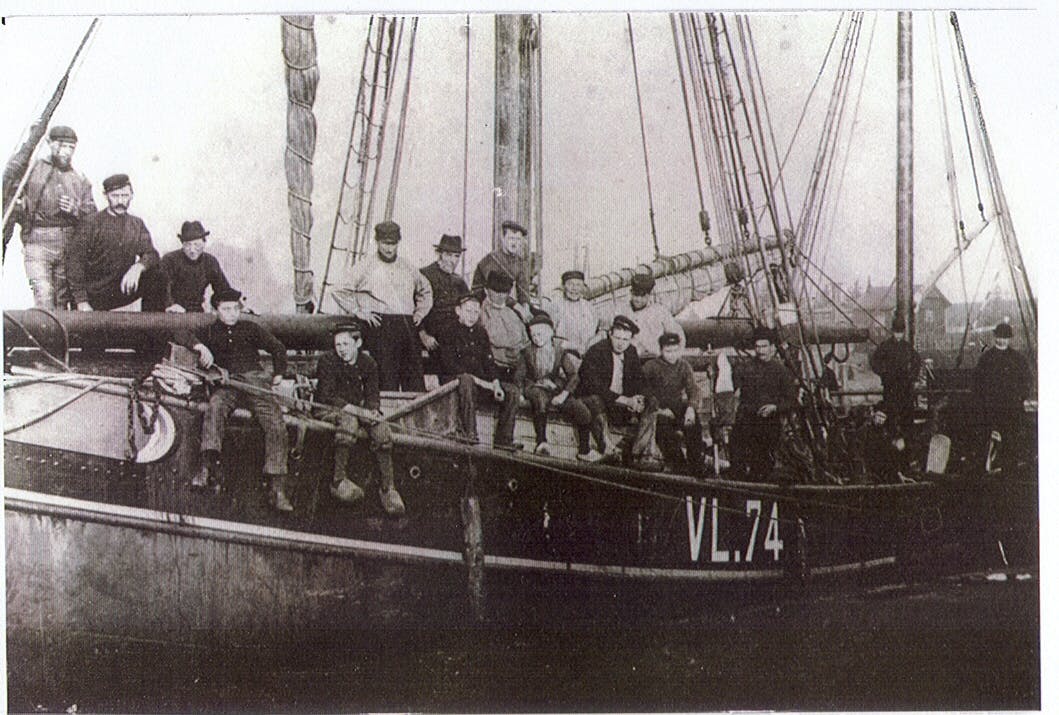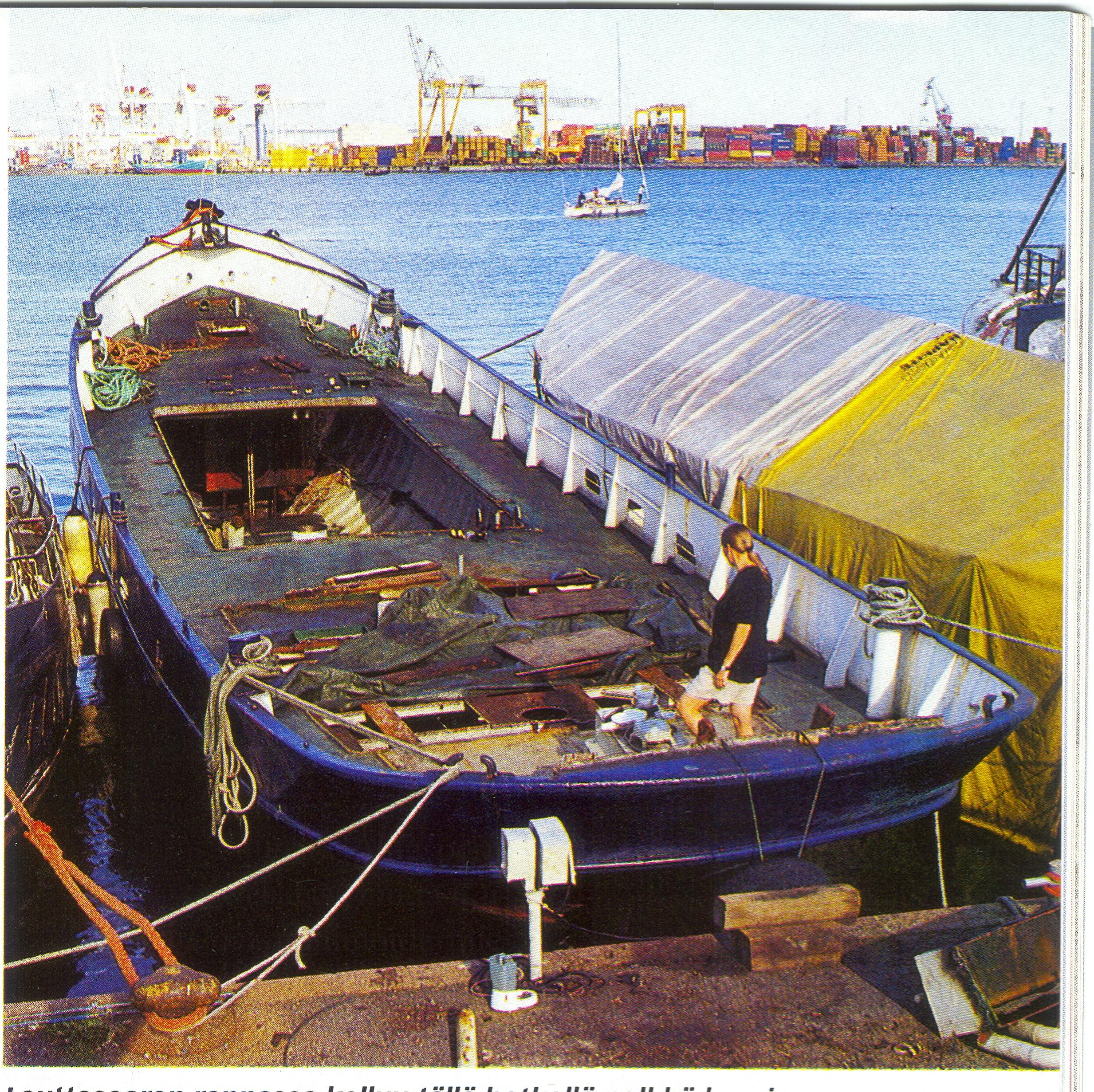History and information
The ship has sailed under four flags and experienced two world wars.
Sailing ship Joanna Saturna, originally VL 74, was built in 1903 in Vlaardingen, Holland. The ship represented a small two-mast sailing ship typical type of her time, which was used for fishing in the Northern Sea. In the eyes of the seafarers and salesman she was an ordinary but practical sailing ship with a logger-tackle. The later history of the ship follows the ordinary pattern for sailing ships: the machinery gets bigger, the rig gets smaller and even the name is changed a few times.

There was not supposed to be any future for Joanna Saturna. She was a memory from the past centuries, from the times before the full-rigged sailing ships. She was a sailing ship which was ment to bring livelihood to one family. The ship should not have been built at all in the beginning of 20th century because all the relations of the ship, usage, crew and the earning logic were based on the traditions of the old world. Only concession for the new times the iron hull.
Joanna Saturna saw her 100th birthday in 2003. The ship had sailed under four flags and through two world wars still intact. She had also succeeded in answering the challenges set by sea fare of the 20th century. The sailing tradition was replaced by effectiveness in then 1920´s and by preciseness – or dullness – in 1950´s.
Only a few ships that have sailed trough an entire century, like Joanna Saturna, have remained in Europe. Everything in the past of Joanna Saturna, is a part of history in Europe. The same kind of values and attitudes could be attached to any ship build anywhere in Europe at the same period of time but only Joanna Saturna has survived through the entire 20th century. In the beginning of the new millennium she got a new life, sailing under the Finnish flag.
During the years Joanna Saturna lost her sails and was used as a freighter in Norway transporting first sand and later fish fodder. The vessel was bought to Finland year 2000 direct from the freight traffic, when the old owner retired.
The dream of a windjammer made of steel
Mikko Karvonen, born in Oulu, had a dream of a sailing ship. He was determined to find a ship that could sail anywhere. After five years of searching, Karvonen finally found his iron sailing ship in Bergen, Norway. That marked the beginning of meticulous restoration work that took another five years.
During the previous decades, Karvonen had gathered a solid knowledge of ships. Having owned two decent-sized boats before, he knew the new ship had to be big enough to tackle even the harshest sea conditions.
When Karvonen found the new steel ship, which had lost its masts and was carrying iron ore in Norway, it was time to depart with his beloved Gertrud, a ship that also belonged to the traditional sailing ship register.
Half a year later, Karvonen sailed the 35-meter-long ship to Lauttasaari, Finland. There, the restoration work began. The plan was clear: return the ship to its former glory as a sailing ship. That meant dismantling everything both on top of the deck and inside. Only the iron frame, gearbox, axle, and propeller remained. After an extensive and meticulous restoration, the ship was finally rigged as a two-masted schooner.
I have taken pictures of the ship every step of the way to remind myself of how vast an undertaking this has been and never to forget the effort that was put in.
Mikko Karvonen
The project has required a lot of sisu—a Finnish word describing determination and perseverance even against the lowest of odds. Completing the project took a considerable amount of money, but most of all, it took even more word from the numerous skilled artisans who have been part of the project. On top of the professionals, quite a few people spent all their free time making this dream a reality.

Previously, Mikko Karvonen worked as a CEO for one of the world's largest technology wholesalers. His passion for sailing was a nice break from his demanding job, which required a lot of travel and time spent at negotiating tables.
The sea represents freedom. Once you leave the shore, you can sail anywhere.
Mikko Karvonen
Karvonen has gone to great lengths to research the history of the ship. The ship is an iron-hulled logger, and only a few still exist in sailing conditions, which made the research relatively straightforward.
Karvonen wanted to respect the old traditions and to return the ship to its former glory as a sailing ship. The massive task meant tearing down the ship and then totally rebuilding it. Nothing but the hull, gear box, axel and propeller were left of the old freighter. The old ship became a true beauty, rigged as a two-mast gaff schooner, a classic of its time.
In designing the new rigging the opinions of members of experts in tradition ships were hear. As one of the many sources was a book by Harold A. Underhill, Mastings & Rigging. After thorough consideration the gaff schooner rig was chosen and the rigging was done during the winter of 2001-2002 in Pietarsaari, Finland.
The ship is iron-hulled logger and she represents a type of sailing ships which only a few have remained in sailing condition. She is the only one of her kind in Finland. Joanna Saturna is registered as a historic class vessel by the Finnish Maritime Museum and the Finnish National Board of Antiquities.
Joanna Saturna from 1903 to 2005
1903 The built of the ship was ready 30th of May 1903 in Vlaardingen, Holland. Gebr. van der Windt built her at the De Hoops shipyard for J.H Warneke from den Haag. She was given name Joanna Saturna I and was registered in Vlaardingen as VL.74. The ship was built for herring fishing; it was a "Herring drifter". The first captain was Leendert Hoogendijk. The hull was made of riveted steel plates and she sailed her first 25 years.
1927 August 25th the ship was sold to B. Heinecke from Hamburg. The new owner changed her to a freighter going on machine power (motor 30 HP Deutche Werke). The rig remained still the same. She got a new name, Marie, in 17th March 1928.
1931 Fifth of March she was sold to Jacob M. Witt from Finkenwärder.
1955 11th of January Witt sold her to Arnfinn Nodevik from Haugesund Norway. Her name was changed to Ran and the new motor was 90HP Wichmann.
1958 The new owner was Aanen and Theodor Mörkesdal from Mandal
1966 Hans Invaldsen from Haugesund bought the ship with 170 000 Norvegian kronor.
1968 The new owner became Raider Iden.
1976 Daniel Veda from Bergen bought the ship and installed a new motor 340 HP MTU.
1995 The ship was used for transporting sand.
1996-2000 The owner was Einar Hernar from Norway. Her name was changed to Fjordsand.
2000 In February 2000 Mikko Karvonen from Helsinki, Finland bought the ship from Bergen in Norway when the old owner Einar Hernar was retired. In June 2000 Karvonen with the help of his friends drove the ship with her own machine from Bergen to Helsinki. The travel of approximately 1100 miles went without any problems. Three years later she had her 100th birthday and she got back her original name Joanna Saturna.
2005 Joanna Saturna goes back to her roots after a long restoration work. The ship was ready to sail in spring 2005
Homeport
Joanna Saturna in Uusikaupunki
The dock of Varvinmäki in Uusikaupunki has long traditions with building ships. It was natural to choose a town, where sailing ship tradition is respected, as Joanna Saturnas hometown. Developing the harbour is one of the biggest priorities of the city of Uusikaupunki.
In Uusikaupunki has been built, renovated and repaired also other important vessels. Frigate Oldenburg was changed during 1930-31 to training ship Suomen Joutsen for the Finnish navy. Sixty years later, year 1992, training ship Helena was built for Sail Training Association Finland..
The hundred-year-old ship represents the maritime heritage of Uusikaupunki. Joanna Saturna is a part of the maritime surroundings and the environment developed with values of ecological durability as well as for the people and companies.
Schooner Joanna Saturna
Size: 34.0 m x 6.0 m Draft: 2.85 m Displacement: 155 tons Sail area: 420 m² Main engine: Sisu Diesel 645, DSBIM, 350 HP Speed: 8 knots Generators: 50 Kva Valmet, 10 Kva Onan Electricity: 380/220/24/12V Hydraulic bow thrusters Main mast: 30 m